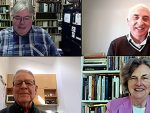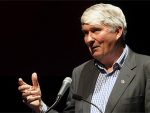On July 15, less than a week before Joe Biden dropped out of the presidential race, Donald Trump chose J.D. Vance, the 39-year-old senator from Ohio (elected in November 2022) as his running mate.
If elected with Trump on November 5, Vance would be the second Catholic vice president in U.S. history after Biden.
However, he would be the first recent Catholic “convert” to rise to that position, and this says a lot about the theological and political trajectories of the Church in the United States.
1. A recent Catholic convert, part of a movement
More than any other church in the West, U.S. Catholicism has a significant portion of converts, that is, of members who joined the Catholic Church as adults (I am married to one of them).
There are many recent converts among Catholics in the United States who make their faith public. In politics, it’s a sea change from the “cradle Catholicism” of older generations like Joe Biden and Nancy Pelosi.
It also differs from the young generation of Catholics in the Democratic Party, like Alexandria Ocasio-Cortez, who prioritise other aspects of their identities in their platform and politics.
Vance has spoken openly of his Catholicism in the recent past: Trump’s campaign between now and November might need some adjustments to that messaging.
By joining the Catholic Church, Vance is part of a larger trend of high-profile conversions.
In recent decades, numerous politicians, journalists, and public intellectuals of conservative persuasion have joined the Catholic Church, viewing it as the “oldest” and most “conservative” Christian tradition.
In contrast to mainline American Protestantism, they see this conversion as a means to save America from decline.
But Vance did it during the Trump years, during his (first) term in office at the White House, in 2019.
Vance’s choice to join the Catholic Church did not interfere but rather accompanied his conversion to Trumpism; while he had been very critical of Trump just a few years earlier, he then embraced and became Trump’s more presentable face.
It is known that Americans tend to change churches or religious traditions often during the course of their lives, more than other Christians in the West.
Vance was exposed to the Southern Baptist preacher Billy Graham by his grandmother, and to Protestant Pentecostalism as a teenager, in a family that, in his 2016 bestselling memoir (cum policy argument) Hillbilly Elegy: A Memoir of a Family and a Culture in Crisis (Harper 2016), he described as deeply dysfunctional.
He wrote it between 2013 and 2015, several years before becoming Catholic, and gives no hint that he had ever considered Catholicism.
Vance mentions the word “Catholic” or “Catholics” only five times in the 264-page book, and he never engages with Catholic teachings in it.
Vance went through a period of atheism, and his efforts to solve the contradictions between faith and science were crucial to his embrace of Christianity and Catholicism.
As he wrote in his autobiographical essay published in 2020 in the Catholic magazine The Lamp, “I read Christopher Hitchens and Sam Harris, and called myself an atheist.”
He was baptized and confirmed in the Catholic Church in August 2019 at St. Gertrude Priory in Cincinnati, Ohio, by the Rev. Henry Stephan, a Dominican friar.
He chose St. Augustine as his patron saint as he said to his friend and “Christianist” ideologue Rod Dreher (author of the 2017 international bestselling manifesto The Benedict Option, who now lives and works at the court of Viktor Orban in Budapest) in an August 2019 interview published in The American Conservative.
Vance is a young and recent Catholic who grew up as a non-denominational Christian and overcame a lot of negative stereotypes about Catholicism typical of American Protestantism (the alleged anti-biblicism and Mariolatry).
In this, there is a certain pride to being Catholic that is counter-cultural and pushes back against the tendency of liberal progressives to blame the Catholic Church for numerous social, cultural, and political ills.
For Vance, Christianity and the Church are not the problem but the solution to the ills of the political-religious project called the United States of America.
He said that the revelations on the abuse crisis in the Catholic Church delayed his conversion but, in the end, did not prevent it. Augustine’s ecclesiology of the ecclesia permixta, made of both saints and sinners, surely helps the faithful to overcome the disgust that has led many cradle Catholics, both on the left and the right, to leave the Church.
He is also someone who chose Catholicism as a response to his perception of the limits of American Protestantism, but also of its limited impact on U.S. culture and politics.
He is a proud Catholic, and like many recent converts from Protestantism does not bring clericalism with him: there is a “lay pride” in that kind of Catholicism – which does not imply a progressive theology, but it’s part of a certain ecclesiological populism and conservative anger against the perceived corruption of the ecclesiastical system and clerical hierarchies.
2. More Silicon Valley than Catholic Social Doctrine
Vance is a mix of Elon Musk-like technocracy and Charles Maurras’s civilisational Catholicism.
He is a protégé of Peter Thiel (the gay billionaire who invented, among other things, PayPal), and his rise has been largely helped by a group of tech titans.
Vance embodies the peculiar alliance in today’s GOP between cultural-religious traditionalists (Catholics, in this case) and Silicon Valley.
His is the anti-elitism proclaimed by the new elites, fueling the rage of those who are socially and economically marginalised.
Vance’s choice to embrace the faith was a way to express his contempt for secular intellectual elites: as he wrote in The Lamp, “Secularism may not have been a prerequisite to joining the elites, but it sure made things easier”.
His is a very American Catholicism, in some sense an “America First Catholicism”, at a distance from Vatican and global Catholicism, which has grown complacent with Trump’s “Make America Great Again”, as well as his gangsterism and violent rhetoric.
Vance’s view of the relations between religion and politics is closer to Pat Buchanan’s, one of the leading Republican and Catholic ideologues of the “culture wars” since the Nixon era, than to John Paul II’s or Benedict XVI’s.
Compared to other recent U.S. converts, he has been less polemical against Pope Francis (even though in 2021, he politely disagreed with the restrictions against the pre-Vatican II “Latin Mass”).
Vance is a politician and cannot damage his appeal to Roman Catholics, who do not like to see the Pope attacked.
Vance’s populism in economic policies could converge with some aspects of Pope Francis’ critique of capitalism, but only at a superficial level.
In the interview with Dreher, he said: “I think the Republican Party has been too long a partnership between social conservatives and market libertarians, and I don’t think social conservatives have benefited too much from that partnership.
“Part of social conservatism’s challenge for viability in the 21st century is that it can’t just be about issues like abortion, but it has to have a broader vision of political economy and the common good.”
Certainly, there is a sea of difference between Francis’ message on the environment and immigration and Vance’s denialism, which is typical of today’s Republican Party.
His Catholicism is not the 20th-century social Catholicism that presupposed a strong role for government programmes: Vance is supported by Silicon Valley libertarians who know they will benefit from a second Trump presidency.
But in public, Vance has embraced populism as a response against the neo-liberal policies that progressive Catholicism has been indifferent to for too long.
3. Theology and Church: Augustine and Aquinas
Theologically, it is relevant that Vance was baptized and confirmed (and arrived at that decision) through connections and conversations with members of the Dominican Order.
Intellectually, it’s a different world from Biden’s connection with the Jesuits, the vanguard of American Catholic liberal progressivism, especially on the East and West Coasts.
The choice of his confirmation saint confirms the key importance of the binomial Augustine – Thomas Aquinas (interpreted in ways that often differ from European, continental theology) for conservative, post-liberal, or anti-liberal Catholicism in contemporary USA.
When he talked about Augustine in his article in The Lamp, Vance emphasised not the doctrinal and ecclesiological side but the personal-emotional (The Confessions) and the political-Weltanschauung (The City of God):
“I had been a fan of Augustine since a political theorist in college assigned City of God.”
As it happens often these days in American colleges and universities, he was exposed to Catholicism not by a theologian, but a political scientist. He expressed an interest in René Girard thanks (again) to Peter Thiel in 2013, six years before his baptism and confirmation.
He is a politician who has thought for a long time about religion, Christianity, and Catholicism, but without over-intellectualising it.
As he said multiple times, “I like that the Catholic Church is old.” He is not a Vatican II Catholic: he is more for ressourcement than aggiornamento in his quest for theological solidity and doctrinal stability.
The Second Vatican Council does not appear in his theological pantheon, nor does it fit his political persona: this is typical of many Catholic converts of political and religious conservative persuasions.
But in his own way, typical of all American Catholics, including those on the conservative side of the spectrum, he is a Catholic who could not do without Vatican II.
His wife, Usha, is the daughter of immigrants from India and she is a Hindu.
When the couple married in 2014, they held two ceremonies, including one where a Hindu pundit blessed them.
When it’s about non-Christian religions, Islam is a different matter, as befits Trump’s running mate: he claimed that the United Kingdom under the Labour Party might be the first “truly Islamist” country with nuclear weapons.
He is on the opposite side of the Catholic social doctrine shaped by Vatican II.
As Michael Sean Winters put it in 2022, “Vance’s fraudulence is discerned in the fact that while he celebrates Catholicism as a vehicle for his sociocultural vision, he departs from the teaching of the Church on a host of issues, from immigration to labor rights to climate change.”
In 2021, Vance attended the Napa Institute’s annual gathering of right-wing Catholic big donors and influencers, with the participation of some conservative prelates.
In 2022, he participated in a public event at a Franciscan Catholic university where speakers argued in favor of integralism.
Vance has yet to answer questions about his own thoughts regarding Catholic integralism, that is, about the relations between the Church and the State, and his views on the recent surge of integralist thought among U.S. Catholic thinkers in the last decade.
(Recently, Trump disavowed the Heritage Foundation’s “Project 2025,” proposals of conservative and right-wing policy to reshape the United States federal government and consolidate executive power if he were to win the 2024 presidential election. But in 2022, he endorsed it, and some of his allies are behind the project.)
He made no mystery in a recent interview with New York Times columnist Ross Douthat that he condoned what Trump did on January 6, 2021, in his attempt to overthrow the government that led to five deaths and the most serious threat in generations to the stability of the American democratic system of government.
That should give U.S. Catholics (bishops included) who have struggled for at least a century and a half to become part of the project of constitutional democracy in America some pause.
4. A face of the new U.S. Catholicism
Where is Vance’s Catholicism going?
What will be its effect on U.S. politics and the Church? In an important difference compared to other prominent Catholic converts, Vance is a politician, and he needs to win in what is now a less religious country, even among conservatives, compared to just ten years ago.
We modern believers are all travelers. Vance has traveled from atheism to Catholicism, from libertarianism to economic populism, from Appalachia to Yale to the Senate in Washington, D.C., via Silicon Valley.
Vance seems to have solved, in his own way, the famous dictum by the great American Catholic writer Walker Percy (another adult convert to Catholicism), who said once that modern man has two choices — Rome or California.
Vance is still traveling and might go much farther, even to the White House. His public Catholicism is subject to more negotiations than for a private person, a journalist, or a pastor.
There was no mention of the Church or Catholicism in his acceptance speech at the Republican National Convention, where religion figured very marginally, following the cues from Trump and a more secular, post-Christian GOP.
He has shifted his position on abortion, leaving pro-life Catholics with a sense of abandonment.
More than moral pragmatism against the cruelty for women of some anti-abortion policies, his shift in position sounds like cynicism in light of the fact that the Supreme Court ruling of 2022 “Dobbs” turned abortion into a political liability for Republicans.
In a campaign fundraising message on July 8, Vance called for mass deportations of immigrants without legal status, a promise also present in the Republican Party platform.
“We need to deport every single person who invaded our country illegally.” It is hard to understand how he will reconcile this with Pope Francis’ and the US bishops’ position on immigration.
Vance is a neo-Catholic millennial in a secularised America that is still the center of the West. Embracing the faith is a form of cultural dissent, a dissent that, while genuine, can get along in an alliance with neo-pagan and anti-religious Silicon Valley technocrats ruling the world.
American Catholicism is no longer just the refuge for conservative ideologues, as it has been between the 1990s and a few years ago.
It’s now a brand for sale, and Vance has also come to the national, political, and global stage thanks to the new masters of the universe.
It’s not clear how interested he is personally in buying that brand and being identified with it because it depends on the political necessities determined by his master, Donald Trump. But others are buying that brand, people politically close to his party.
Trump’s choice marks “the anointing of a youthful vice president and heir apparent,” as his friend, New York Times columnist, and fellow Catholic convert Ross Douthat put it.
If elected with Donald Trump, J.D. Vance might not only end up running the country but also contribute from that pulpit to changing the Catholic Church in the United States.
- First published in La Croix
- Massimo Faggioli is an Italian academic, Church historian, professor of theology and religious studies at Villanova University, columnist for La Croix International, and contributing writer to Commonweal.
News category: Analysis and Comment.




